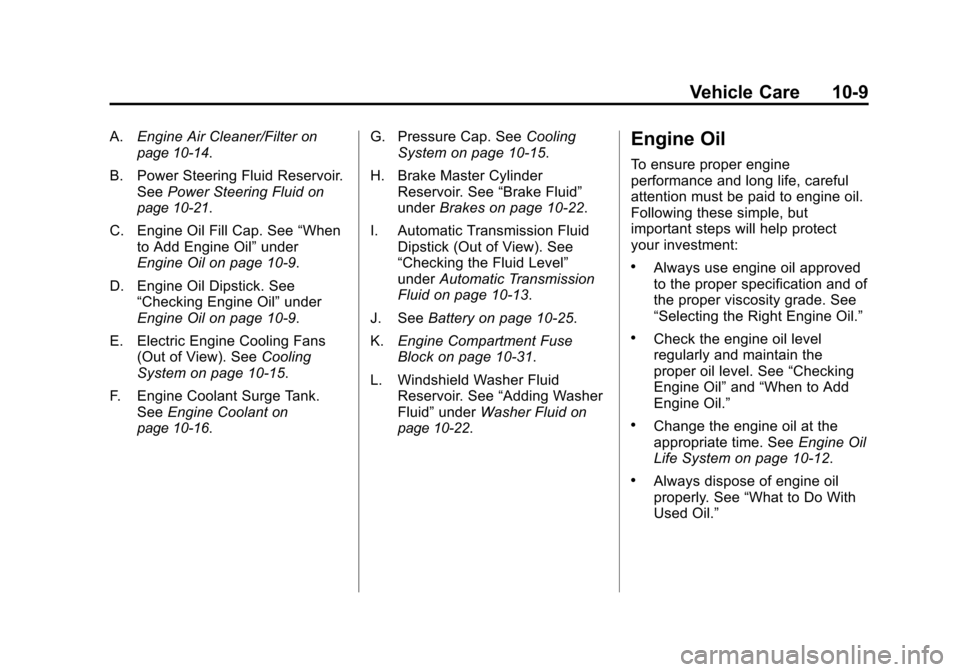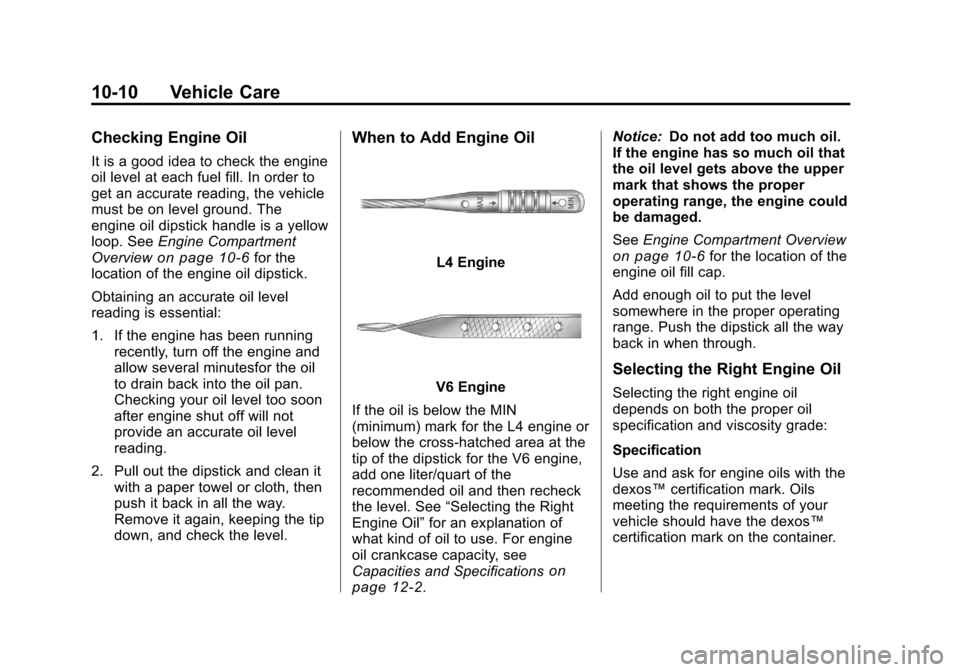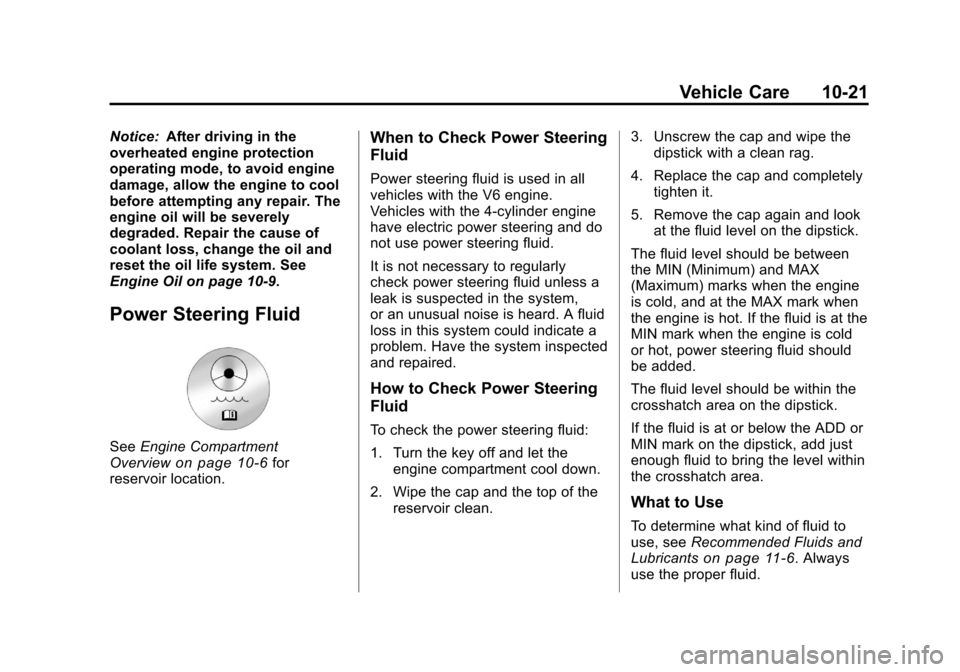2011 CHEVROLET MALIBU oil dipstick
[x] Cancel search: oil dipstickPage 249 of 382

Black plate (7,1)Chevrolet Malibu Owner Manual - 2011
Vehicle Care 10-7
A.Engine Air Cleaner/Filteron
page 10‑14.
B. Engine Cooling Fan (Out of View). See Cooling System
on
page 10‑15.
C. Engine Oil Fill Cap. See “When
to Add Engine Oil” under
Engine Oil on page 10‑9.
D. Engine Oil Dipstick (Out of View). See “Checking Engine
Oil” under Engine Oil
on
page 10‑9. E. Engine Coolant Surge Tank.
See Engine Coolant
on
page 10‑16.
F. Pressure Cap. See Cooling
System
on page 10‑15.
G. Brake Master Cylinder Reservoir. See “Brake Fluid”
under Brakes on page 10‑22. H.
Battery on page 10‑25.
I. Windshield Washer Fluid Reservoir. See “Adding Washer
Fluid” under Washer Fluidon
page 10‑22.
J. See Engine Compartment Fuse
Block on page 10‑31.
Page 251 of 382

Black plate (9,1)Chevrolet Malibu Owner Manual - 2011
Vehicle Care 10-9
A.Engine Air Cleaner/Filteron
page 10‑14.
B. Power Steering Fluid Reservoir. See Power Steering Fluid
on
page 10‑21.
C. Engine Oil Fill Cap. See “When
to Add Engine Oil” under
Engine Oil on page 10‑9.
D. Engine Oil Dipstick. See “Checking Engine Oil” under
Engine Oil on page 10‑9.
E. Electric Engine Cooling Fans (Out of View). See Cooling
System on page 10‑15.
F. Engine Coolant Surge Tank. See Engine Coolant
on
page 10‑16. G. Pressure Cap. See
Cooling
System on page 10‑15.
H. Brake Master Cylinder Reservoir. See “Brake Fluid”
under Brakes on page 10‑22.
I. Automatic Transmission Fluid Dipstick (Out of View). See
“Checking the Fluid Level”
under Automatic Transmission
Fluid on page 10‑13.
J. See Battery on page 10‑25.
K. Engine Compartment Fuse
Block on page 10‑31.
L. Windshield Washer Fluid Reservoir. See “Adding Washer
Fluid” under Washer Fluidon
page 10‑22.
Engine Oil
To ensure proper engine
performance and long life, careful
attention must be paid to engine oil.
Following these simple, but
important steps will help protect
your investment:
.Always use engine oil approved
to the proper specification and of
the proper viscosity grade. See
“Selecting the Right Engine Oil.”
.Check the engine oil level
regularly and maintain the
proper oil level. See “Checking
Engine Oil” and“When to Add
Engine Oil.”
.Change the engine oil at the
appropriate time. See Engine Oil
Life System on page 10‑12.
.Always dispose of engine oil
properly. See “What to Do With
Used Oil.”
Page 252 of 382

Black plate (10,1)Chevrolet Malibu Owner Manual - 2011
10-10 Vehicle Care
Checking Engine Oil
It is a good idea to check the engine
oil level at each fuel fill. In order to
get an accurate reading, the vehicle
must be on level ground. The
engine oil dipstick handle is a yellow
loop. SeeEngine Compartment
Overview
on page 10‑6for the
location of the engine oil dipstick.
Obtaining an accurate oil level
reading is essential:
1. If the engine has been running recently, turn off the engine and
allow several minutesfor the oil
to drain back into the oil pan.
Checking your oil level too soon
after engine shut off will not
provide an accurate oil level
reading.
2. Pull out the dipstick and clean it with a paper towel or cloth, then
push it back in all the way.
Remove it again, keeping the tip
down, and check the level.
When to Add Engine Oil
L4 Engine
V6 Engine
If the oil is below the MIN
(minimum) mark for the L4 engine or
below the cross‐hatched area at the
tip of the dipstick for the V6 engine,
add one liter/quart of the
recommended oil and then recheck
the level. See “Selecting the Right
Engine Oil” for an explanation of
what kind of oil to use. For engine
oil crankcase capacity, see
Capacities and Specifications
on
page 12‑2. Notice:
Do not add too much oil.
If the engine has so much oil that
the oil level gets above the upper
mark that shows the proper
operating range, the engine could
be damaged.
See Engine Compartment Overview
on page 10‑6for the location of the
engine oil fill cap.
Add enough oil to put the level
somewhere in the proper operating
range. Push the dipstick all the way
back in when through.
Selecting the Right Engine Oil
Selecting the right engine oil
depends on both the proper oil
specification and viscosity grade:
Specification
Use and ask for engine oils with the
dexos™ certification mark. Oils
meeting the requirements of your
vehicle should have the dexos™
certification mark on the container.
Page 256 of 382

Black plate (14,1)Chevrolet Malibu Owner Manual - 2011
10-14 Vehicle Care
Change the fluid and filter at the
intervals listed inScheduled
Maintenance
on page 11‑2, and be
sure to use the transmission fluid
listed in Recommended Fluids and
Lubricants on page 11‑6.
Notice: Use of the incorrect
automatic transmission fluid may
damage the vehicle, and the
damages may not be covered by
the vehicle's warranty. Always
use the automatic transmission
fluid listed in Recommended
Fluids and Lubricants
on
page 11‑6.
For the 2.4 L and 3.6 L engines,
the transmission fluid will not reach
the end of the dipstick unless the
transmission is at operating
temperature. If the transmission
fluid level needs to be checked,
please take the vehicle to the
dealer.
Engine Air Cleaner/Filter
See Engine Compartment Overviewon page 10‑6for the location of the
engine air cleaner/filter.
When to Inspect the Engine Air
Cleaner/Filter
Inspect the air cleaner/filter at the
scheduled maintenance intervals
and replace it at the first oil change
after each 80 000 km (50,000 mi)
interval. See Scheduled
Maintenance
on page 11‑2for
more information. If driving in dusty/
dirty conditions, inspect the filter at
each engine oil change.
How to Inspect the Engine Air
Cleaner/Filter
To inspect the air cleaner/filter,
remove the filter from the vehicle
and lightly shake the filter to release
loose dust and dirt. If the filter
remains caked with dirt, a new filter
is required. To inspect or replace the engine air
cleaner/filter:
1. Remove the spring clamps that
hold the cover on.
2. Lift off the cover.
Page 263 of 382

Black plate (21,1)Chevrolet Malibu Owner Manual - 2011
Vehicle Care 10-21
Notice:After driving in the
overheated engine protection
operating mode, to avoid engine
damage, allow the engine to cool
before attempting any repair. The
engine oil will be severely
degraded. Repair the cause of
coolant loss, change the oil and
reset the oil life system. See
Engine Oil on page 10‑9.
Power Steering Fluid
See Engine Compartment
Overviewon page 10‑6for
reservoir location.
When to Check Power Steering
Fluid
Power steering fluid is used in all
vehicles with the V6 engine.
Vehicles with the 4-cylinder engine
have electric power steering and do
not use power steering fluid.
It is not necessary to regularly
check power steering fluid unless a
leak is suspected in the system,
or an unusual noise is heard. A fluid
loss in this system could indicate a
problem. Have the system inspected
and repaired.
How to Check Power Steering
Fluid
To check the power steering fluid:
1. Turn the key off and let the
engine compartment cool down.
2. Wipe the cap and the top of the reservoir clean. 3. Unscrew the cap and wipe the
dipstick with a clean rag.
4. Replace the cap and completely tighten it.
5. Remove the cap again and look at the fluid level on the dipstick.
The fluid level should be between
the MIN (Minimum) and MAX
(Maximum) marks when the engine
is cold, and at the MAX mark when
the engine is hot. If the fluid is at the
MIN mark when the engine is cold
or hot, power steering fluid should
be added.
The fluid level should be within the
crosshatch area on the dipstick.
If the fluid is at or below the ADD or
MIN mark on the dipstick, add just
enough fluid to bring the level within
the crosshatch area.
What to Use
To determine what kind of fluid to
use, see Recommended Fluids and
Lubricants
on page 11‑6. Always
use the proper fluid.